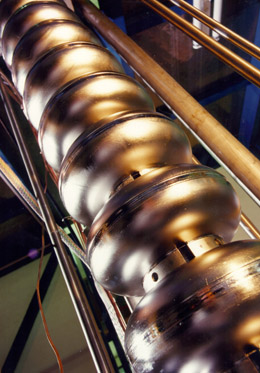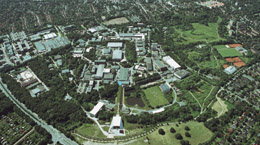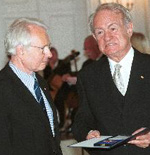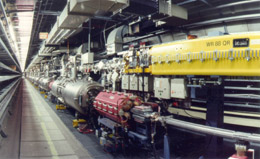 |
|
Interactions: Communicating particle physics in the 21st century
by Paul Söding
It is often — and rightly — questioned whether society really can and should pay for such large, expensive facilities as the accelerators used in particle physics research. History shows that large-scale scientific equipment is by no means a recent phenomenon. As far back as the 16th century, the Danish crown provided the astronomer Tycho Brahe with an entire island, as well as almost unlimited financial aid and human resources, to establish a large astronomical observatory. Brahe was then able to measure the positions of the planets and stars with unprecedented accuracy. In the hands of the ingenious Johannes Kepler, Brahe’s results paved the way not only for modern-day astronomy and cosmology — sciences concerned solely with the search for truth and understanding — but also for the field of mechanics founded by Galileo Galilei and Isaac Newton. They in turn laid the groundwork for a field of applied science that defines our modern world. Without Galileo and Newton,there would be no cars and no airplanes today — in fact,none of the technology from which we now benefit would exist. Large-scale equipment is required in many fields of science. The exploration of our planet by expeditions with big sailing ships in centuries past exemplifies well what motivates major research enterprises: pushing back scientific frontiers,the fascination of the unpredictable,and the conviction that costs, efforts and risks involved are all eventually worth it for society.
It is sometimes lamented that research equipment is becoming ever larger and more expensive, that experiments are taking longer, and that research is carried out more and more in the style of an industrial project. This is, however, not due to megalomania on the part of the researchers but to scientific progress. We can now probe more deeply into the structure of matter, reach previously inaccessible parts of the cosmos, and tackle increasingly complex issues. The laws of nature leave us no other choice but to use large-scale instruments and facilities as well as the most advanced technology. This is particularly obvious in astronomy, which requires increasingly large and sophisticated telescopes to peer into the farthest regions of the cosmos. The results continually give us new and surprising insights into our world as we probe farther and farther into the depths of space and time. Instruments such as the Cosmic Microwave Background Explorer and the Hubble Space Telescope have led to a revolution in our view of the universe.In elementary particle research,the deeper we probe the innermost layers of matter,and the more we learn about the basic laws and interrelations in nature ’s functioning, the greater the resources we need —in terms of ideas,instruments and effort.In particular,we require increasingly powerful “microscopes ” — the particle accelerators.
What benefits can we expect from this type of research? The effort and resources that mankind has invested in studying nature have always proved to be worthwhile in the end. Tycho Brahe’s huge astronomy project is an excellent example. We do not yet know how the insight gained from particle research will eventually rank against other human achievements. One fact, however,we can already state for sure: Invented, developed and built to find out just what holds the world together, various types of particle accelerators are already proving their usefulness in a multitude of applications. From the diagnosis and treatment of illnesses to the generation of synchrotron radiation and neutrons for research into wide- ranging disciplines,these tools benefit many fields —from physics and chemistry to geology, materials science,biology,medicine,archaeology and even criminology. The full potential for accelerator applications might be so expansive that only future generations will know how to exploit them. Also,the abundance of new technologies that particle physicists have developed for their experiments have proved beneficial in many ways, in medical diagnosis and beyond.In the form of the World Wide Web,new technologies growing from particle physics have even brought about a revolution in the global networking of information and knowledge.
Experience has shown that it is impossible to predict the entire extent of knowledge,innovation and value that will arise from a given research project.But it has become apparent time and again that the development of an innovative,large-scale research instrument is likely to set an important milestone along the path of progress in scientific insight and the search for truth. Major advances in the basic sciences,and the discovery and exploitation of new areas of research,have often been closely connected with the creation of new, specific instruments. The large accelerators for elementary particle research represent such new instruments.They are helping us to probe deeply into the heart of matter.The complex,dynamic structure of quarks, antiquarks and gluons that make up the innermost part of our matter is revealed with increasing clarity, enhancing our understanding of the structure of matter.This involves more than just being familiar with the functions of and the interactions between the smallest particles.It also includes comprehending why nature is the way it is —and why it is only the way it is.Particle accelerators are indispensable in the pursuit of this quest.They will guarantee us much excitement in learning what new insights and surprises are waiting around the corner,on the great journey of discovery into the deep secrets of matter. —Paul Söding was the Deutsches Elektronen Synchrotron Director of Research from 1982 to 1991,and served as head of DESY Zeuthen from 1992 to 1998.
Respond online at http://www.fnal.gov/pub/ferminews/interactions/index.html or send an email to ferminews@fnal.gov |



